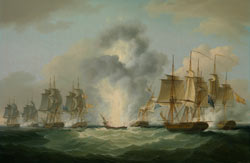Mercedes Returns to Spain
Sails trimmed to the wind
Escalation in regional conflicts during the heat of Spanish conquests in the late eighteenth and early nineteenth centuries took its toll on Peru. By the year 1800, Peru's population dwindled to one fifth its size as casualty. Spain continued pillaging, all the while shipping as much plunder as possible across the Atlantic in name of the crown, without mercy for lives affected. Despite efforts to continue, Spain's struggle increased by pressure from Peruvian civil unrest. The peril in Peru devastated millions and in order for the crown to justify its efforts, it became increasingly necessary to transport treasures far away from points of conflict or else jeopardize Spain's successful pillaging.

In 1804, as carried out many times in the past, cargo vessels with sails trimmed to the wind, departed the Caribbean transporting a variety of goods destined for Spain. The weather was mostly favorable and allowed the ships to make decent time without major problems. Traveling together on this voyage were four vessels. The Medea, Clara, Fama along with the famed Mercedes. On board, a generous cargo obtained from Spain's successes in the region including wool, tin, copper, seal skins, oil, silver dollars, and gold ingots. In fact, the manifest records declared in detail the fleet carried nearly two million silver dollars, one-hundred and fifty-thousand gold ingots, and a silver value of almost one and a half million in remaining cargo.
The ships succeeded in crossing the Atlantic, and were on their final approach to Spain when they met with four British warships in the straight of Gibraltar. The Indefatigable, Medusa, Lively, and the Amphion. Mercedes opened fire across the bow at the British, initiating the battle not long after initial confrontation. Medea somehow managed to escape without pursuit as the British elected to concentrate fire on Mercedes, the instigator as it were. Clara pleaded no contest, surrendering midst scattering of the Spanish fleet. The Fama escaped near the start of battle, sailed for a short while, then was later captured. One ship of the eight involved in battle, the Nuestra Senora de las Mercedes, also known in translation as Our Lady of Mercy, sunk as a result. She took with her, over a million silver pieces, at least half of copper and a quarter of tin reported in the fleet's cargo manifest.
Two-hundred years pass after Our Lady of Mercy was shown no mercy at the blast of British cannons. Explorers on a mission hunting for the wreck, finally discover it not far from a last known location. Salvage operations commenced, recovering seventeen tons of lost treasure, mostly retrieving bundles of silver coins fused together and a few gold coins with a combined value of roughly five-hundred million; a total of just under six-hundred thousand coins. According to cargo manifests though, this may be a good portion of what was on board at the time of sinking, but a fair amount of gold and silver plus portions of copper and tin are still unaccounted for. Future dives on the wreck may prove to be prosperous in recovering lost heritage, and perhaps, in discovering the remaining shiny cargo of Mercedes.
